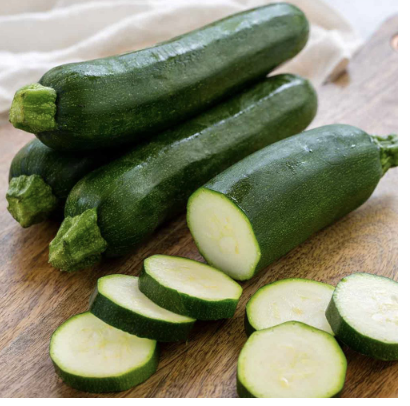Zucchini
Zucchini is a versatile and healthy vegetable that is easy to store if you follow a few basic guidelines. Here's how to store zucchini properly:
Keep zucchini dry: Moisture is the enemy of zucchini, as it can cause the vegetable to rot quickly. Store zucchini in a dry place, and avoid washing it until you are ready to use it.
Do not store zucchini in plastic bags: Storing zucchini in plastic bags can trap moisture, which can cause it to spoil quickly. Instead, store zucchini in a breathable container or paper bag to allow air to circulate.
Store zucchini in the refrigerator: Zucchini can be stored in the refrigerator for up to 5 days. Wrap it in a paper towel or cloth and place it in the crisper drawer of the refrigerator.
Freeze zucchini for long-term storage: If you have more zucchini than you can use in a few days, you can freeze it for long-term storage. To freeze zucchini, slice it into rounds or dice it into cubes, blanch it in boiling water for 1-2 minutes, then plunge it into ice water to stop the cooking process. Drain and pat dry the zucchini, then place it in a freezer-safe container or plastic bag and freeze for up to 3 months.
By following these tips, you can store zucchini properly and enjoy its delicious flavor and health benefits for longer.
Here are just a few ways to prepare zucchini.
Experiment with different methods and flavor combinations to find your favorite way to enjoy this delicious and nutritious vegetable.
Grilled zucchini: Brush-sliced zucchini with olive oil and season with salt and pepper. Grill over medium-high heat until tender and lightly charred.
Sauteed zucchini: Heat olive oil in a pan over medium heat. Add sliced zucchini and cook until tender and lightly browned, about 5-7 minutes. Season with salt, pepper, and herbs like thyme or oregano.
Zucchini fritters: Grate zucchini and squeeze out the excess moisture. Mix with beaten eggs, flour, grated Parmesan cheese, and chopped herbs. Form into patties and fry in olive oil until crispy and golden brown.
Zucchini noodles: Use a spiralizer or vegetable peeler to make zucchini noodles. Cook in boiling water for 1-2 minutes, then drain and toss with your favorite sauce.
Stuffed zucchini: Cut zucchini in half lengthwise and scoop out the seeds. Stuff with a mixture of cooked ground meat, rice, and vegetables, then bake until tender.
Zucchini soup: Saute onion and garlic in olive oil, add chopped zucchini and vegetable broth, and simmer until tender. Blend with an immersion blender until smooth, then season with salt and pepper.
Zucchini is a low-calorie vegetable that is rich in nutrients. Here are the nutrition facts for 1 medium-sized zucchini (about 196 grams):
Calories: 33
Protein: 2 grams
Fat: 0.6 grams
Carbohydrates: 6 grams
Fiber: 2 grams
Sugar: 4 grams
Vitamin C: 58% of the Reference Daily Intake (RDI)
Vitamin B6: 16% of the RDI
Folate: 10% of the RDI
Vitamin K: 8% of the RDI
Riboflavin: 8% of the RDI
Potassium: 10% of the RDI
Manganese: 8% of the RDI
Zucchini is also a good source of antioxidants, including carotenoids like lutein and zeaxanthin. These compounds can help protect against oxidative stress and inflammation, which are associated with many chronic diseases.
Overall, zucchini is a nutritious and versatile vegetable that can be incorporated into a healthy diet in many ways.
SHOP ZUCCHINI ON THE PROFOUND VIRTUAL MARKET
